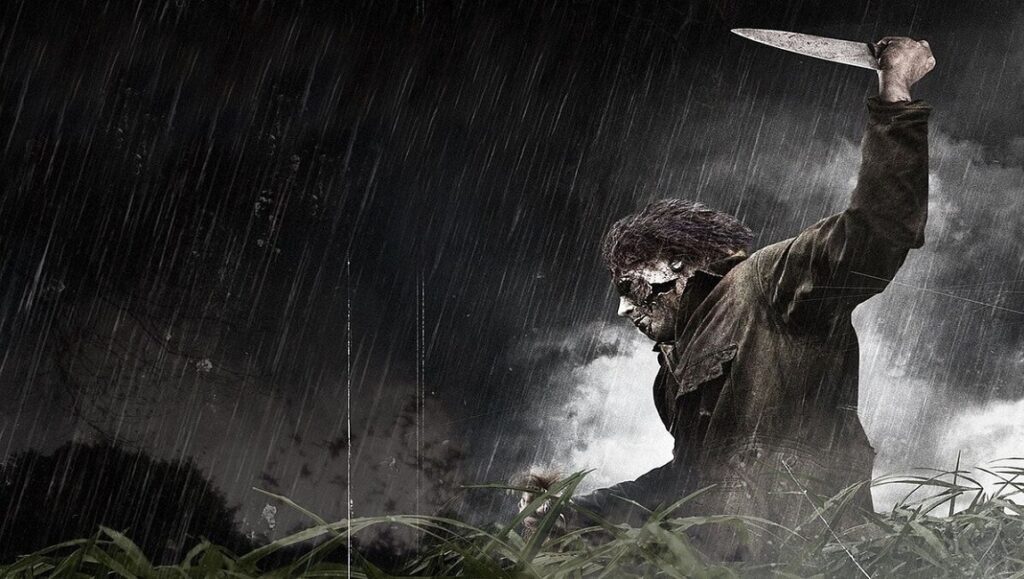Rob Zombie’s die has been cast. In four pitches, he’s had a foul, a hit, and two huge strikes — an average that won’t put him on the bench, but suggests he will never be an all star. And in the hearts and minds of his fans, there is an undeniable feeling of disappointment. Zombie’s career as a director started exactly how one might expect with House of 1000 Corpses, a riotous B-movie that relished the absurdity of the genre. But then, out of nowhere, comes The Devil’s Rejects — a stroke of genius that delivered everything you might want out of an exploitation thriller, plus stylistic bravado to boot. The time was ripe for a director who was willing to raise the bar on a genre that had fallen so low. Oh, how quickly things fall apart. The news that Zombie was going to direct a “re-envisioning” of John Carpenter’s classic Halloween gave great pause. Why remake one of the most iconic horror films ever made? Why indeed. A muddled piece of rattrap pop psychology, Rob Zombie’s Halloween failed to add anything to the franchise and placed Zombie right alongside the rest of the horror film hacks. Perhaps deciding that he enjoyed having his name in the title, he signed up for a re-envisioned sequel and, having exhausted the themes of Serial Killer Psychology 101, he moved on to Psychotic Symbolism 101.
Rob Zombie’s Halloween II (not to be confused with the original Rick Rosenthal’s Halloween II) is a mixed bag of brainless brutality, witless metaphor, and poorly executed narrative. The film opens suddenly with an educational tidbit about the symbolism of white horses in dreams, and then, just as abruptly, the title card arrives, accompanied by a loud gunshot and a scream to wake you up for what follows: an impossibly long dream sequence that has Laurie Strode waking up in a fit and heading straight to the medicine cabinet for her Thorazine. One year after “the night that Michael returned,” Laurie is trying to carry on with her life. But traumatized by the events of one year ago and plagued by Michael’s missing body, she can’t help but envision the worst. With irony that is not very dramatic, we know that the worst is true and Michael is still very much alive. Like some sort of vagabond mountain-man, Michael spends his time walking cross-country, mostly through pastures, on a madman walkabout. Wearing a large coat, his face is buried beneath a dark hood and a full beard and only pulls out his mask when he means business. But Michael’s spiritual journey is about to end. Visions of his dead mother leading a white horse beckon him back to Haddonfield to reunite with his little sister, because, as the film’s tagline states, “family is forever.” Poor Laurie is naive to the fact that part of her inner struggle is that of Angel Myers, Michael’s long lost sister. The truth is about to be revealed, however, in Dr. Loomis’ new book, The Devil Walks Among Us. Loomis has turned into an ego-driven psychiatrist celebrity who cares less about the lives his book will effect than his wallet. He aims to cash in by digging the dirt on Michael Myers and everyone associated with him, including Laurie. Traveling to Haddonfield for a book signing, Loomis is unknowingly walking into a Myers’ family reunion as the film takes a predictable downward spiral.
Halloween II strives for a modern timelessness that could have been interesting, but instead just ends up being lazy. Soundtrack features “Night in White Satin” and “Kick Out the Jams” suggest one time period, but contradict just about everything else in the movie except the fact that no one has a cell phone. The disjointed time frame only echoes the incoherent tone. Take crudely scripted teen angst and layer it with some of the most heavy-handed symbolic nonsense, and you get a movie that is less annoying than it is dumbfounding. The film is shamelessly littered with dramatically lit nighttime images of Michael’s mother, played by Sherri Moon Zombie, and the ever-potent symbol of the white horse that would have best been left for a White Zombie music video. The cast, most of whom are reprising their roles from Halloween, do their best with transparent dialogue, but their best just ain’t good enough to save this dog.
Perhaps not as paradoxical as it seems, Zombie finds his stride when Michael pulls out his blade. With attention and care that is completely lacking in the rest of the film, the bloodletting is a bright spot is the careless production. Zombie retains the former WCW wrestler Tyler Mane (aka Big Sky) to play Michael, whose physical stature in itself is overwhelming. If the Friday the 13th reboot gave Jason speed, then the Halloween redux gave Michael an animal-like physicality, subtly embellished with grunts. The visceral soundscape of death is vividly depicted, occasionally cutting away from the visual action to give the sound a gruesome life of its own. The film ends, as most of this ilk do, in a sequel-ready stance. Laurie Strode has successfully made the transition to Angel Myers, and in possibly the most cartoonish moment of the film, emerges from a shack wearing Michael’s huge mask over her head with knife in hand. Although Rob Zombie has insisted that two is enough (announcing instead that he will remake The Blob — no joke), the Weinsteins’ are already talking about Halloween 3D for next summer. Quality be damned, they obviously know a good investment when they see it. The franchise has a life of its own, and — as the box office numbers confirm — if they make it, we will watch it.


Comments are closed.